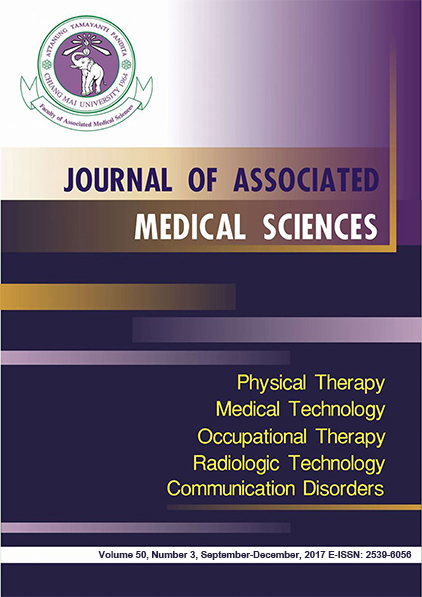Relationship between Physiological Profile Assessment (PPA) and Berg Balance Scale (BBS) scores in patients with stroke
Main Article Content
Abstract
Background: Balance impairment and falls are a major problem and common in patients with stroke. Physiological Profile Assessment (PPA) was developed to identify physiological impairments underlying balance disorders and risk of falls in elderly people. The PPA has been used in patients with stroke but not as common as Berg Balance Scale (BBS).
Objectives: To determine the relationship between PPA scores and BBS scores in patients with stroke.
Materials and methods: Thirty patients with stroke (22 males, 8 females; mean age 61.07±12.34 years; mean post-stroke time 32.5±31.6 months) voluntarily participated in the study. The PPA and BBS were administered to all participants. Spearman correlation coefficient was used to determine the relationship between the PPA and BBS scores. The significance level was set at p<0.05.
Results: Participants had mean PPA score of 2.88±1.56 points and mean BBS score of 42.80±12.38 points. Spearman correlation coefficient analysis revealed that the PPA scores had moderately negative correlation with the BBS scores (r = -0.475, p=0.008).
Conclusion: Significant correlation between PPA and BBS scores could be due to the activities tested in the BBS require integration of physiological factors assessed in the PPA. As PPA provides information on physiological impairments underlying risk of falls, it is beneficial for planning interventions that are specific to patient’s problems. However, studies on psychometric property of PPA in patients with stroke are needed.
Article Details
Personal views expressed by the contributors in their articles are not necessarily those of the Journal of Associated Medical Sciences, Faculty of Associated Medical Sciences, Chiang Mai University.
References
2. Mayo NE, Korner-Bitensky N, Kaizer F. Relationship between response time and falls among stroke patients undergoing physical rehabilitation. Int J Rehabil Res 1990; 13(1): 47-55. doi: 10.1097/00004356-199003000-00005
3. Hyndman D, Ashburn A, Stack E. Fall events among people with stroke living in the community: Circumstances of falls and characteristics of fallers. Arch Phys Med Rehabil 2002; 83(2): 165-70. doi: 10.1053/apmr.2002.28030
4. Tyson SF, Hanley M, Chillala J, Selley A, Tallis RC. Balance disability after stroke. Phys Ther 2006; 86(1): 30-8. doi: 10.1093/ptj/86.1.30
5. Blennerhassett JM, Dite W, Ramage ER, Richmond ME. Changes in balance and walking from stroke rehabilitation to the community: a follow-up observational study. Arch Phys Med Rehabil 2012; 93(10): 1782-7. doi: 10.1016/j.apmr.2012.04.005
6. Kanis J, Oden A, Johnell O. Acute and long-term increase in fracture risk after hospitalization for stroke. Stroke 2001; 32(3): 702-6. doi: 10.1161/01.STR.32.3.702
7. Berg K, Wood-Dauphinee S, Wiliams JL, Maki B. Measuring balance in the elderly: preliminary development of an instrument. Physiother Can 1989; 41: 304-11. doi: 10.3138/ptc.41.6.304
8. Harris JE, Eng JJ, Marigold DS, Tokuno CD, Louis CL. Relationship of balance and mobility to fall incidence in people with chronic stroke. Phys Ther 2005; 85(2): 150
9. Andersson AG, Kamwendo K, Seiger A, Appelros P. How to identify potential fallers in a stroke unit: validity indexes of 4 test methods. J Rehabil Med 2006; 38(3): 186-91. doi: 10.1080/16501970500478023
10. Blum L, Korner-Bitensky N. Usefulness of the Berg Balance Scale in stroke rehabilitation: a systematic review. Phys Ther 2008; 88(5): 559-66. doi: 10.2522/ptj.20070205
11. Korner-Bitensky N, Wood-Dauphine´e SL, Teasell R, et al. Best versus actual practices in stroke rehabilitation: results of the Canadian National Survey. Stroke 2006; 37: 631
12. Mao HF, Hsueh IP, Tang PF, Sheu CF, Hsieh CL. Analysis and comparison of the psychometric properties of three balance measures for stroke patients. Stroke 2002; 33(4): 1022-7 doi: org/10.1161/01
13. Berg KO, Wood-Dauphinee SL, Williams JI, Maki B. Measuring balance in the elderly: validation of an instrument. Can J Public Health 1992; 83 Suppl 2: S7-11
14. Shumway-Cook A, Baldwin M, Polissar NL, Gruber W. Predicting the probability for falls in community-dwelling older adults. Phys Ther 1997; 77: 812-9
15. Maeda N, Kato J, Shimada T. Predicting the probability for fall incidence in stroke patients using the Berg Balance Scale. J Int Med Res 2009; 37(3): 697-704
16. Lord SR, Clark RD, Webster IW. Physiological factors associated with falls in an elderly population. J Am Geriatr Soc 1991; 39(12): 1194-200. doi: 10.1111/j.1532-5415.1991.tb03574.x
17. Lord SR, Ward JA, Williams P, Anstey KJ. Physiological factors associated with falls in older community-dwelling women. J Am Geriatr Soc 1994; 42(10): 1110-7. doi: 10.1111/j.15325415.1994.tb06218.x
18. Lord SR, Menz HB, Tiedemann A. A physiological profile approach to falls risk assessment and prevention. Phys Ther 2003; 83(3): 237-52. doi: 10.1017/CBO9780511722233.018
19. Dean CM, Rissel C, Sherrington C, Sharkey M, Cumming RG, Lord SR, et al. Exercise to enhance mobility and prevent falls after stroke: the community stroke club randomized trial. Neurorehabil Neural Repair 2012; 26(9): 1046-57. doi: 10.1177/1545968312441711
20. Salter K, Jutai JW, Teasell R, Foley NC, Bitensky J, Bayley M. Issues for selection of outcome measures in stroke rehabilitation: ICF activity. Disabil Rehabil 2005; 27(6): 315-40. doi: 10.1080/09638280400008545
21. Stevenson TJ: Detecting change in patients with stroke using the Berg Balance Scale. Aust J Physiother 2001; 47(1): 29-38
22. de Oliveira R, Cacho EW, Borges G. Post-stroke motor and functional evaluations: a clinical correlation using Fugl-Meyer assessment scale, Berg balance scale and Barthel index. Arq Neuropsiquiatr 2006; 64(3b): 731-5. doi: 10.1590/S0004-282X2006000500006
23. Vistamehr A, Kautz SA, Bowden MG, Neptune RR. Correlations between measures of dynamic balance in individuals with post-stroke hemiparesis. J Biomech 2016; 49(3): 396-400. doi: 10.1016/j.jbiomech.2015.12.047
24. Hoang PD, Cameron MH, Gandevia SC, Lord SR. Neuropsychological, balance, and mobility risk factors for falls in people with multiple sclerosis: a prospective cohort study. Arch Phys Med Rehabil 2014; 95(3): 480-6. doi: 10.1016/j.apmr.2013.09.017
25. Latt MD, Lord SR, Morris JG, Fung VS. Clinical and physiological assessments for elucidating falls risk in Parkinson’s disease. Mov Disord 2009; 24(9): 1280-9. doi: 10.1002/mds.22561
26. Taylor ME, Delbaere K, Lord SR, Mikolaizak AS, Brodaty H, Close JC. Neuropsychological, physical, and functional mobility measures associated with falls in cognitively impaired older adults. J Gerontol A Biol Sci Med Sci 2014; 69(8): 987-95. doi: 10.1093/gerona/glt166


